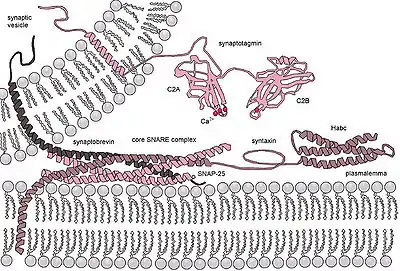Synaptotagmine
Synaptotagmine sind eine Gruppe von 17 an Zellmembranen lokalisierten Proteinen, die sich durch eine N-terminale Transmembranregion (TMR), eine variable Verbindung und zwei C-terminale C2-Domänen (C2A und C2B) auszeichnen. Es gibt mehrere C2-Domänen-tragende Proteingruppen, die mit Synaptotagminen verwandt sind, darunter Ferline, E-Syts und MCTPs, sowie RIMs, Munc13s und B/K.

Funktion
Auf der Grundlage ihrer endokrinen Verteilung im Gehirn und ihrer biochemischen Fähigkeiten, binden C2-Domänen der Synaptotagmine Calcium. Es wird daher angenommen, dass Synaptotagmine als Calciumsensoren dienen, die die Freisetzung von Neurotransmittern und Hormonen steuern.
Obwohl alle Synaptotagmine sehr ähnlich strukturiert sind, binden nur acht (1, 2, 3, 5, 6, 7, 9, und 10) Calcium.
Proteine aus der Gruppe der Synaptotagmine finden sich durch die Interaktion mit β-neurexin[1] bzw. SNAP-25[2] in der Exozytose in der frühen (Andocken der synaptischen Vesikel an der präsynaptischen Membran) und in der späten Phase.[3][4][5]
2006 konnte in einem Versuch gezeigt werden, dass Synaptotagmin 1 in der Anwesenheit von Calcium Complexin aus dem SNARE-Komplex verdrängen kann. Dies wird als eine der letzten chemischen Reaktionen bei der Exozytose betrachtet.[6]
Die C2-Domänen steuern dann die Fusion der synaptischen Vesikel im Rahmen der Exozytose.[7][8]
Einzelnachweise
- Fukuda M, Moreira JE, Liu V, Sugimori M, Mikoshiba K, Llinas RR: Role of the conserved WHXL motif in the C terminus of synaptotagmin in synaptic vesicle docking. In: Proc Natl Acad Sci USA. 97, 2000, S. 14715–14719. doi:10.1073/pnas.260491197.
- Schiavo G, Stenbeck G, Rothman JE, Söllner TH: Binding of the synaptic vesicle v-SNARE, synaptotagmin, to the plasma membrane t-SNARE, SNAP-25, can explain docked vesicles at neurotoxin-treated synapses. In: Proc Natl Acad Sci USA. 94, 1997, S. 997–1001. doi:10.1073/pnas.94.3.997.
- Pang ZP, Melicoff E, Padgett D, Liu Y, Teich AF, Dickey BF, et al.: Synaptotagmin-2 is essential for survival and contributes to Ca2+ triggering of neurotransmitter release in central and neuromuscular synapses. In: The Journal of Neuroscience. 26, 2006, S. 13493–13504. doi:10.1523/JNEUROSCI.3519-06.2006.
- Maximov A, Südhof TC: Autonomous function of synaptotagmin 1 in triggering synchronous release independent of asynchronous release. In: Neuron. 48, 2005, S. 547–554. doi:10.1016/j.neuron.2005.09.006.
- O'Connor V, Lee AG: Synaptic vesicle fusion and synaptotagmin: 2B or not 2B?. In: Nature Neuroscience. 5, 2002, S. 823–824. doi:10.1038/nn0902-823.
- Tang J, Maximov A, Shin OH, Dai H, Rizo J, Südhof TC: A complexin/synaptotagmin 1 switch controls fast synaptic vesicle exocytosis. In: Cell. 126, Nr. 6, 2006, S. 1175–1187. doi:10.1016/j.cell.2006.08.030.
- Zimmerberg J, Akimov SA, Frolov V: Synaptotagmin: fusogenic role for calcium sensor?. In: Nature Structural & Molecular Biology. 13, 2006, S. 301–303. doi:10.1038/nsmb0406-301.
- Fernández-Chacón R, Königstorfer A, Gerber SH, García J, Matos MF, Stevens CF, et al.: Synaptotagmin I functions as a calcium regulator of release probability. In: Nature. 410, 2001, S. 41–49. doi:10.1038/35065004.